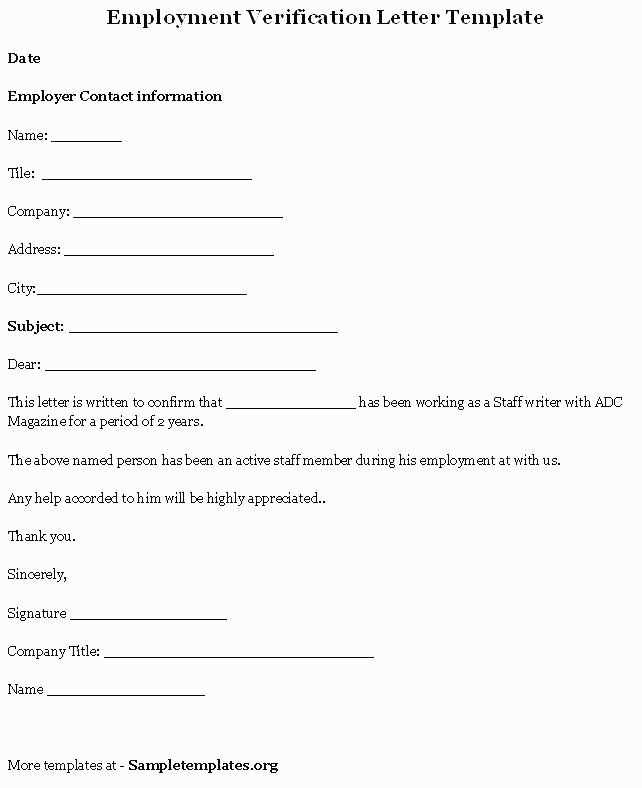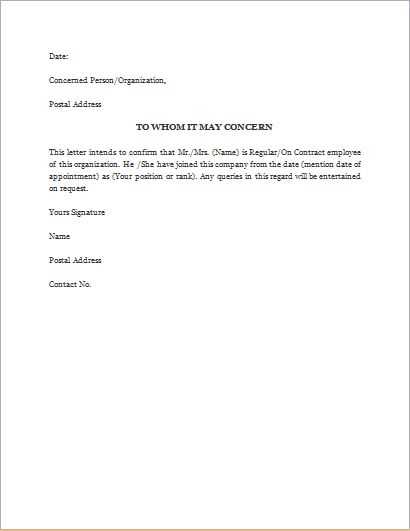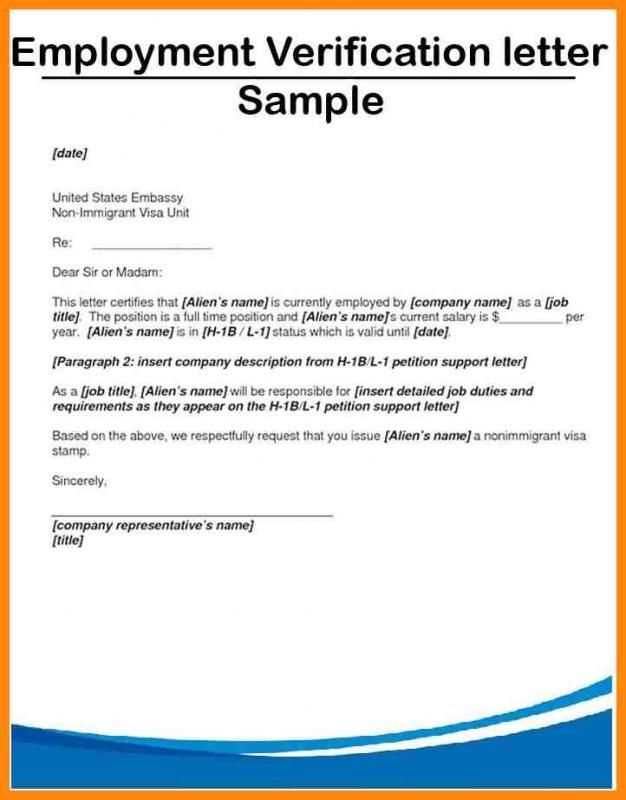Employment Confirmation Letter Template for Word

When it comes to verifying someone’s job status, having a clear and well-structured document is crucial. This type of official note can be requested for various purposes, such as securing a loan, applying for a visa, or confirming work experience for future opportunities. Crafting this communication correctly ensures that it serves its purpose effectively and is accepted without confusion.
Understanding the key elements that make up such a document is important. By following a simple, organized structure, the document becomes a professional representation of employment history and job-related details. Customizing the content to fit specific needs is also essential, ensuring that all necessary information is included in a concise and accurate manner.
Getting the format right is equally important. A well-organized document not only reflects professionalism but also makes it easier for the recipient to review the information. By using proper layout, it can help avoid unnecessary delays and potential misinterpretations.
While the content is important, knowing what to avoid is equally valuable. Mistakes in wording or missing crucial details can lead to the rejection of the document. A simple guide will help you navigate these common pitfalls and create a letter that is both effective and well-received.
Why Use an Employment Verification Document

When seeking to verify an individual’s work history or job status, having a formal and well-structured document can serve as a valuable tool. This type of written proof ensures clarity and provides credibility when required by institutions or organizations for various reasons, such as financial transactions or application processes. Its importance lies in its ability to offer tangible evidence of someone’s current or past role in a professional setting.
Official Use and Requirements
Often, such documents are requested by government agencies, banks, or other entities that need to assess an individual’s financial stability, professional background, or qualifications. By providing a reliable source of information, these documents help in making informed decisions. Without them, many processes such as loan approvals or visa applications could be delayed or denied.
Benefits of Using a Structured Document
A well-organized and accurate document offers several benefits beyond mere verification. It presents the necessary details in a concise manner, helping to avoid confusion and minimizing the chances of misunderstandings. Moreover, a formal format can enhance the perception of professionalism, reflecting well on both the employer and the employee.
| Benefit | Impact |
|---|---|
| Clear Communication | Prevents misunderstandings and ensures accuracy |
| Professionalism | Enhances the perception of both employer and employee |
| Speed | Speeds up processes such as loan approval or visa requests |
Key Elements of a Verification Document
To ensure that a work status statement is clear, professional, and useful, certain components are essential. These key sections provide the necessary information in an organized and concise manner, making the document effective for its intended purpose. Each part plays a role in verifying the person’s job details while maintaining clarity and professionalism.
Start by including the individual’s full name, job title, and employment dates. These details establish the basic information about the person being verified. Additionally, it’s important to mention the company or organization they work for, along with the company’s contact information, in order to provide a point of reference for verification.
Another crucial element is the statement of employment status. Clearly specifying whether the individual is full-time, part-time, or on a contract helps avoid any confusion. If applicable, providing details about their role and key responsibilities can add extra clarity to the verification process. A concluding note from the employer confirming that all the information is accurate will further enhance the document’s validity.
How to Customize Your Document Format
Personalizing a professional work status document is essential to ensure it meets the specific needs of both the individual and the requesting party. Customizing the format allows you to highlight the most relevant details and make the document align with the purpose for which it is intended. Whether you are preparing it for a loan, visa application, or other use, the right adjustments can make a significant difference.
Adjusting the Content to Fit the Purpose
The first step in customization is to adjust the information based on the document’s intended use. For example, if the document is being used for a mortgage application, including the employee’s salary or work stability might be necessary. On the other hand, for a simple verification, just the job title and dates of employment could be sufficient.
- Include additional details such as salary, benefits, or job responsibilities when needed.
- Be clear about the purpose of the document, especially when it’s required for financial or legal reasons.
- Ensure the format remains clean and professional, with no unnecessary information.
Formatting Tips for Easy Readability
Ensuring that the document is easy to read and professionally formatted is just as important as its content. The layout should be simple yet organized, highlighting the key sections for quick reference. Using clear headings and bullet points can help make the document more digestible.
- Start with the basics: Include company name, employee name, and position in the header.
- Maintain consistent font style and size throughout the document.
- Use bullet points for job responsibilities or key facts to make them stand out.
Legal Considerations for Work Verification Documents

When creating a document that validates someone’s job status or work history, it’s essential to be aware of the legal aspects that govern such communications. Ensuring the document complies with legal standards not only protects the employer but also ensures the information provided is accepted by all relevant parties, such as government institutions or financial organizations.
One important consideration is the accuracy of the information presented. Any false statements or omissions could lead to legal repercussions. It’s crucial that the details provided, such as job title, employment dates, and salary, are correct and supported by records from the employer’s side. Inaccurate data can damage the credibility of the document and harm the employee’s professional reputation.
Another factor to keep in mind is confidentiality. The document should contain only the necessary information required for verification and avoid disclosing personal or sensitive details that are not relevant to the request. Employers must be cautious about sharing private information without the explicit consent of the employee.
Formatting Tips for Professional Documents

When creating a formal work-related document, it’s essential to focus on its structure and appearance to ensure that it appears polished and professional. Proper formatting not only enhances readability but also helps convey the necessary information clearly and effectively. Following a few simple guidelines can make a significant difference in how the document is perceived.
Keep It Simple and Clean
A cluttered or overly complex design can distract from the content. It’s best to keep the formatting simple, with clear headings and sufficient spacing between sections. This approach ensures that the key points stand out and the document is easy to navigate.
- Use a professional font such as Arial or Times New Roman.
- Limit the use of bold, italics, or underlining to emphasize only the most important information.
- Ensure consistent spacing and alignment for a neat and organized look.
Highlight Key Information

Emphasizing crucial details, such as the person’s role, job dates, and employer’s contact details, can help readers quickly grasp the main points. This can be done using bullet points or headings, but avoid overcomplicating the layout with excessive styles or fonts.
- Highlight job titles, dates of employment, and responsibilities for easy reference.
- Use bold text or italics for important facts, but keep it to a minimum.
- Ensure proper alignment of text, particularly in tables, to maintain readability.
Common Mistakes to Avoid in Documents
When preparing a formal document for work verification, it’s crucial to avoid common errors that can undermine the professionalism and accuracy of the content. These mistakes can lead to confusion, legal issues, or a lack of trust in the document. Ensuring the proper structure and content helps convey the intended message effectively and accurately.
One common mistake is providing incorrect or incomplete information. Missing details, such as incorrect job titles or dates, can create confusion and may lead to unnecessary delays. Always double-check the information to ensure everything is accurate and relevant.
Another mistake is failing to maintain a formal tone throughout the document. Using casual language or informal phrasing can make the document appear unprofessional. It’s important to keep the language clear, concise, and respectful, regardless of the situation.
Key mistakes to watch out for:
- Incorrect job titles, roles, or work dates.
- Failure to use formal language and tone.
- Omitting crucial details such as employer contact information.